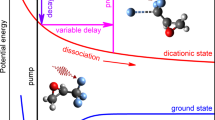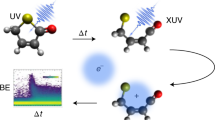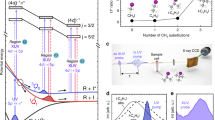Abstract
Many molecules can rotate freely around single bonds and thereby interconvert between different conformations, such as gauche and anti 1,2-disubstituted ethane, a classic example of conformational isomerism1,2,3. Even though rotation occurs rapidly at room temperature, the product selectivity seen in some reactions has been explained by conformation-dependent reaction mechanisms4,5: if reactant molecules differing only in their conformation are located at different positions on the reaction path, they may undergo different reactions. But a direct verification of this effect is difficult, because the energy barrier separating conformational isomers is so low that under ambient conditions reactants with more than one conformation will be present1. But by using temperatures low enough to suppress the interconversion between different conformations, gauche-1-iodopropane ions and anti-1-iodopropane ions have been selectively generated6. Here we show that the kinetic energy released during the photodissociation of 1-iodopropane ions depends strongly on the conformation of the ions. Thermodynamic arguments and ab initio calculations indicate that this difference in kinetic energy release results from differences in the reaction mechanism, with gauche-1-iodopropane ions forming 2-propyl ions and anti-1-iodopropane ions forming protonated cyclopropane ions. These findings suggest that the well-known concept of conformation selection forms the basis of a simple scheme for reaction control, thus providing in some cases an attractive alternative for more involved schemes that utilize the phase and pulse shape of laser beams to control chemical reactions7,8,9,10.
This is a preview of subscription content, access via your institution
Access options
Subscribe to this journal
Receive 51 print issues and online access
$199.00 per year
only $3.90 per issue
Buy this article
- Purchase on Springer Link
- Instant access to full article PDF
Prices may be subject to local taxes which are calculated during checkout



Similar content being viewed by others
References
Eliel, E. L. & Wilen, S. H. Stereochemistry of Organic Compounds 597–664 (Wiley, New York, 1994).
Kirby, A. J. Stereoelectronic Effects 24–33 (Oxford Univ. Press, New York, 1996).
Ramsay, O. B. Stereochemistry 1–42 (Heyden, London, 1981).
Winstein, S. & Holness, N. J. Neighboring carbon and hydrogen. XIX. t-Butylcyclohexyl derivatives. Quantitative conformational analysis. J. Am. Chem. Soc. 77, 5562–5578 (1955).
Eliel, E. L. & Lukach, C. A. Conformational analysis. II. Esterification rates of cyclohexanols. J. Am. Chem. Soc. 79, 5986–5992 (1957).
Park, S. T., Kim, S. K. & Kim, M. S. One-photon mass-analyzed threshold ionization spectroscopy of 1- and 2-iodopropanes in vacuum ultraviolet. J. Chem. Phys. 114, 5568–5576 (2001).
Brumer, P. & Shapiro, M. Laser control of molecular process. Annu. Rev. Phys. Chem. 43, 257–282 (1992).
Kosloff, R. et al. Wavepacket dancing—achieving chemical selectivity by shaping light-pulses. Chem. Phys. 139, 201–220 (1989).
Zhu, L. et al. Coherent laser control of the product distribution obtained in the photoexcitation of HI. Science 270, 77–80 (1995).
Assion, A. et al. Control of chemical reactions by feedback-optimized phase shaped femtosecond laser-pulse. Science 282, 919–922 (1998).
Schlag, E. W. ZEKE Spectroscopy 112–121 (Cambridge Univ. Press, Cambridge, 1998).
Hilber, G., Lago, A. & Wallenstein, R. Broadly tunable vacuum-ultraviolet/extreme-ultraviolet radiation generated by resonant third-order frequency conversion in krypton. J. Opt. Soc. Am. B 4, 1753–1764 (1987).
Kimura, K., Katsumata, S., Achiba, Y., Yamazaki, T. & Iwata, S. Handbook of HeI Photoelectron Spectra of Fundamental Organic Molecules 87 (Japan Scientific Societies, Tokyo, 1981).
Jarrold, M. F., Illies, A. J. & Bowers, M. T. Energy disposal in photodissociation from magic angle measurements with a crossed high-energy ion beam and laser beam: photodissociation dynamics of the (N2)+2 cluster in the 458–514 nm range. J. Chem. Phys. 81, 214–221 (1984).
Kim, D. Y., Choe, J. C. & Kim, M. S. Photodissociation dynamics of the propargyl bromide molecular ion. J. Chem. Phys. 113, 1714–1724 (2000).
Brand, W. A., Baer, T. & Klots, C. E. Kinetic energy release distribution in the fragmentation of energy-selected iodopropane ions. Chem. Phys. 76, 111–120 (1983).
Levsen, K. Fundamental Aspects of Organic Mass Spectrometry 166–172 (Chemie, Weinheim, 1978).
Lias, S. G., Rebbert, R. E. & Ausloos, P. Carbonium ions in radiation chemistry. II. Isomerization process in protonated cyclopropane and cyclobutane ions. J. Am. Chem. Soc. 92, 6430–6440 (1970).
Vogel, P. Carbocation Chemistry 331–335 (Elsevier, Amsterdam, 1985).
Koch, W., Liu, B. & Schleyer, P. V. R. Definitive characterization of the C3H7+ potential energy surface. J. Am. Chem. Soc. 111, 3479–3480 (1989).
Frisch, M. J. et al. Gaussian98, Revision A.6 (Gaussian, Inc., Pittsburgh, Philadelphia, 1998).
Pedley, J. B., Naylor, R. D. & Kirby, S. P. Thermochemical Data of Organic Compounds 215 (Chapman and Hall, London, 1986).
Chong, S. L. & Franklin, J. L. Heats of formation of protonated cyclopropane, methylcyclopropane, and ethane. J. Am. Chem. Soc. 94, 6347–6351 (1972).
Chase, M. W. Jr et al. JANAF Thermochemical Tables Third Edition. J. Phys. Chem. Ref. Data 14 (suppl. 1) 1332 (1985).
Acknowledgements
This work was supported by CRI, the Ministry of Science and Technology, Republic of Korea. S.T.P. thanks the Ministry of Education, Republic of Korea, for support through the Brain Korea 21 program.
Author information
Authors and Affiliations
Corresponding author
Ethics declarations
Competing interests
The authors declare no competing financial interests.
Rights and permissions
About this article
Cite this article
Park, S., Kim, S. & Kim, M. Observation of conformation-specific pathways in the photodissociation of 1-iodopropane ions. Nature 415, 306–308 (2002). https://doi.org/10.1038/415306a
Received:
Accepted:
Issue Date:
DOI: https://doi.org/10.1038/415306a
This article is cited by
-
Conformer-specific hydrogen atom tunnelling in trifluoromethylhydroxycarbene
Nature Chemistry (2017)
Comments
By submitting a comment you agree to abide by our Terms and Community Guidelines. If you find something abusive or that does not comply with our terms or guidelines please flag it as inappropriate.



